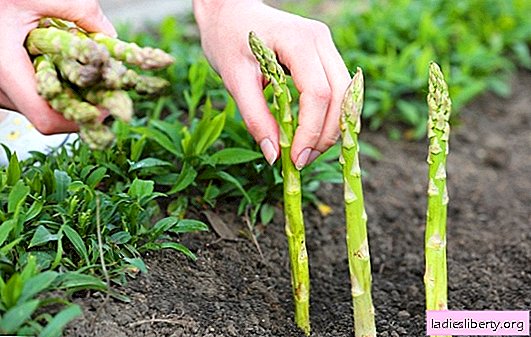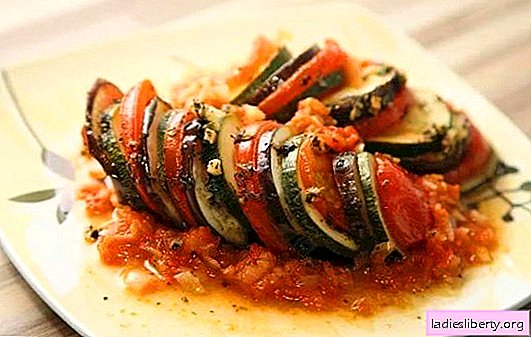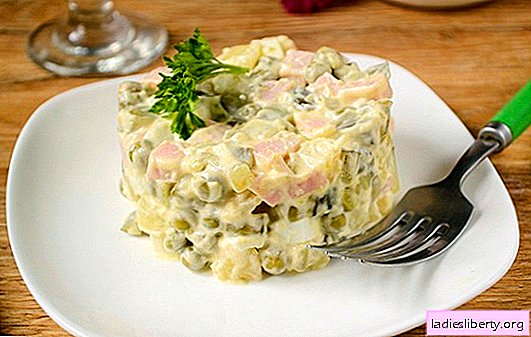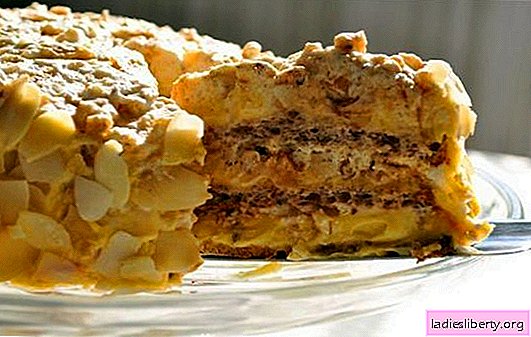
Asparagus is a rather rare perennial plant, the young shoots of which are eaten, and the fluffy stems are used for decorating bouquets.
It is both easy and difficult to grow it on its plot at the same time: it does not need special growing conditions, tolerates cold Russian winters, but at the same time, you can harvest the first crop only in the third year of cultivation.
Before deciding to plant asparagus, you should determine the basic conditions for its cultivation.
Perennial plantIt can grow in one place for about two decades, occupies a large area, because the stems can be one and a half meters tall and half a meter wide.
Asparagus is demanding for high rates soil fertility and her drainage, but not picky about light and can give high yields in dark areas.
Agricultural technology will vary slightly between different species, of which there are about 150.
Asparagus: growing. Selection of planting material
In our country, the most common for planting: "Vienna", "Snow head", "Ulmanskaya" - varieties of green asparagus; "Elephant", "Gigantic" - representatives of the popular white asparagus; "Arzhanteilskaya", "Urozhaynaya" - more rare redhead varieties. The most productive for breeding are male F1 hybrids.
Asparagus can be planted with seeds, seedlings, one-year-old seedlings, division of rhizomes. It is possible to purchase any of the listed types of planting material on the market.
It does not require much effort and time. growing asparagus seeds. For this, the seed is scattered on the selected site after the snow melts, sprinkled with peat and watered. Shoots should appear in about a month, and sprouted sprouts should be thinned or transferred to a permanent place. This method does not differ in good productivity, and young plants can die if they fall under spring frosts.
Growing Asparagus Seedlings - The process is quite time-consuming, since the seeds germinate for a long time and have poor germination. To start planting choose the time from mid-March to late April so that after warming up the soil in early-mid-June, young plants are planted on the site.

asparagus seedlings
It is possible to reduce the appearance time of sprouts by preliminary soaking seeds. To do this, they are pre-disinfected by placing in a weak solution of potassium permanganate, and then they are transferred to a warm place, filling up with a small amount of water. Temperature and humidity are maintained for 4-5 days, water changes daily. Then the seeds are laid out on a wet burlap and kept still spraying from the spray gun for 10 more days - until the first sprouts appear.
“Hatching” seeds are transferred to the ground, to pre-prepared seedling boxes, planted to a depth of 2.5 cm at a distance of 5 cm from each other, or into peat cups one at a time. The soil mixture for seedlings should consist of garden soil, humus, peat, sand in a ratio of 2: 1: 1 :, be loose and have good drainage. 10 days after the appearance of green sprouts, a complex mineral fertilizer is applied under the plants, for example, wood ash (we select birch ash and plant it in a proportion of 1 glass per 10 liters of water).
When choosing containers should proceed from the area of the site: if the planting is significant, you should choose boxes in which young shoots will be thinned out in a growth phase of about 8-10 cm and, if necessary, grown in a greenhouse with a prolonged cold spring.
Seedlings can be purchased from summer residents in the spring, choosing one-year-old plants when purchasing, since later planting material can take root poorly and in this case it is preferable to propagate it with rhizomes.
Seedlings are placed on a plot of parallel ridges, with a distance of at least 50 cm from each other (preferably 1.5 meters). For planting, they dig a trench with a tire of 40-50 cm. And the same depth. Individual plants are planted on mounds 20–25 cm high at a distance of 30–50 cm from each other, after which they straighten the roots, sprinkle them with earth and carefully compact the soil at the roots. Thus, the above-ground part of the plant turns out to be in a trench 15–20 cm deep. This facilitates watering and filling the ground as the asparagus grows. Do not prune seedlings to prevent root rot. In autumn, when the asparagus will have 2-4 sprouts and still undeveloped rhizome, the trenches should be completely covered with earth and spud, raising the ground part for a better wintering.

seedlings of asparagus
Growing asparagus rhizomes - The most common method of landing, because it gives very high results.
When choosing rhizomes for planting, it is not difficult to make a mistake, since asparagus should not have sprouts. Dry, but juicy, without visible traces of diseases and pests, the dun root can be easily divided into several parts, dried sections and placed in the ground according to the same scheme as the one-year-old seedlings. The buds, which are at the root, will give sprouts and asparagus the very next year will give at least thin, but quite edible shoots. You can plant asparagus by dividing rhizomes in spring and autumn. Suitable for breeding are the powerful roots of three to five year old plants, purchased no earlier than one day before planting.

asparagus: growing from rhizome
Soil selection and site preparation for planting asparagus
Asparagus is not demanding on the plantation - enough lack of through wind. It will take root well when planting along fences and fences. The plant will bear fruit when placed on darkened areas, with the only difference that the harvest period will occur later than in a sunny place. Despite the fact that asparagus is a perennial plant, in order to avoid infection with pests, you should not cultivate it in the same place for more than 5-6 years.
Fertile, sandy loamy soil is suitable for growing asparagus. The site is selected on a hill and the ridges are specially raised. It is completely cleared of weeds and dug up, bringing additional peat and sand into heavy ground to form loose soil.
Care and fertilizer for growing asparagus
Gardeners who decide to grow asparagus are accompanied by two main activities for caring for it: loosening and weeding. Plants do not tolerate stagnant moisture, need good drainage and are not able to compete with weeds in the first years of life. In addition, weeds can carry diseases and pests that affect asparagus.
First loosening should be carried out as early as possible in the spring, but so as not to damage the roots of plants and shoots. The first loosening of the soil and cultivation after harvesting must be accompanied by the introduction of organic and mineral fertilizers. After that, the soil is mulched, covering with a layer of peat, tree bark, hay or grass.
In the spring and in the dry summer season should moisten the soil thoroughlypreventing its drying out and stagnation of water. If young shoots are forced to grow in dry land, they will acquire a bitter taste. In addition, adult plants spud: in the fall - for a better wintering, in the spring - to protect edible shoots from the sun. In the second year, the ground part is rounded up to a height of about 40 cm, in subsequent years - by 50-60 cm. When hilling, humus is added to the soil. In no case should not use unspoiled manure, the plant will "burn" from it.
When preparing asparagus for wintering, additional cover one-year-old plants with grass, leaves, manure or spruce branches. If winter is expected to be snowless, it will not be superfluous to dig them on top of the ground. Adult plants cut off for restleaving 10 cm of the stem at the root. Asparagus, susceptible to disease and pests, is completely cut, the tops are burned.
Adult plants respond well to peat mulching: in winter, a layer of mulch about 10 cm high protects against frost, and in the spring it mixes with the top layer of the earth when loosening. In addition, the constant mulching with a thinner layer during the warm period of the year protects the asparagus from drying out and weed emergence.
Autumn and spring care also includes subcortical superphosphate from the calculation of 30 - 50 gr. per 1 square. m., and 40% potassium salt, at the rate of 25-30 gr. on 1 sq.m. You can replace chemical fertilizers by making a solution of wood ash, at the rate of 100 gr. for 10 liters water, or make fertilizer dry when loosening at the rate of 80-100 gr. on 1 sq.m.
Harvesting Asparagus
If plants are grown for the decoration of bouquets, then selectively cut the green mass can be in the second year of cultivation.
If the gardener wants to get good harvest edible shoots, then cut the stems should not. In the third year with good care, asparagus should form strong and fairly dense bushes, which in early spring will give the first harvest.
If the plant is still not strong, then the best will be postpone harvest for another year, caring for the culture in the same way as before.
Harvesting shoots begins in mid-April, when they reach technical ripeness. Ready to eat shoots about 1 cm in diameter and about 10 cm in length. The gardener should carefully monitor the beginning of the harvest period, otherwise the shoots will appear above the ground, turn green and ogrubeyu. An indicator of the beginning of the “strada” is the cracking of the surface of the soil, then the ridge of the earth is raked and the stem is carefully cut off. It is more convenient to do this with a special knife for harvesting asparagus. From one bush in the third year of cultivation, it is possible to collect up to five ready-to-eat shoots. At the end of the earth over the rhizomes again spud to the same height.
Repeat this procedure as new shoots germinate every three days until the beginning - mid-June. Every year the number, thickness and length of shoots increases, it will be possible to gather up to 15 technically ripe shoots from one bush. After harvesting, three to five shoots are left on each bush, which form a lush green mass.
Diseases and Pests of Asparagus
One of the most common diseases affecting asparagus stalks is a fungal infection, rust. In the spring, small yellow spots appear on the greens, and in the autumn the plants turn yellow prematurely, their growing season is reduced, the buds are laid not on the roots, but on the base of the stems, which significantly reduces the yield for next year. Shoots get lower taste.
Asparagus is more susceptible to rust, growing on heavy soils, as well as in low areas close to waterlogging. In addition, an excess of nitrogen and a lack of potash fertilizers adversely affects. Work on raising ridges, loosening, removing weeds and increasing the drainage capacity of the soil will help prevent infection.
The next disease is root rot - affects the underground part of the plant. It causes mechanical damage to the roots and stains the root neck in a brown-purple color. Avoid contamination will help change the area for planting asparagus every 5-6 years, as well as a neat landing without damaging the root system.
Phimosis and chalcosporosis affect the ground part of plants and are not as common in Russia as insect pests that cause significant damage to the crop.
Asparagus fly lays eggs on young shoots of asparagus, and hatched white larvae eat them, making moves, lead to withering and death of the ground part of the plant. The flies themselves are brown in color and widespread in the south of the country, where they can be seen in the spring, leaving winter pupae in the ground. To fight insects, you can not use chemicals, so you should cut off infected shoots as quickly as possible and burn them. A good result in the fight against pupae is given by deep autumn digging of the earth between the aisles.

asparagus fly - the main enemy
Asparagus leaf beetle has dark gray or yellow larvae, which, along with beetles, destroy not only shoots, but also berries. Beetles of red color with a black border can be collected and destroyed, and infected shoots with larvae are cut and burned. In one summer, these insects can produce at least 2 generations, pupating in the ground under plants.











